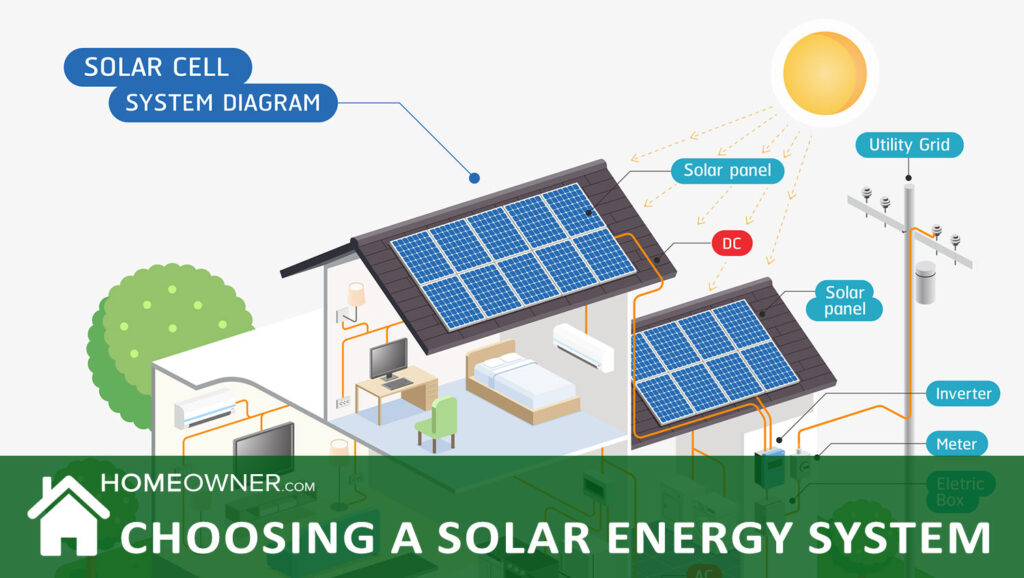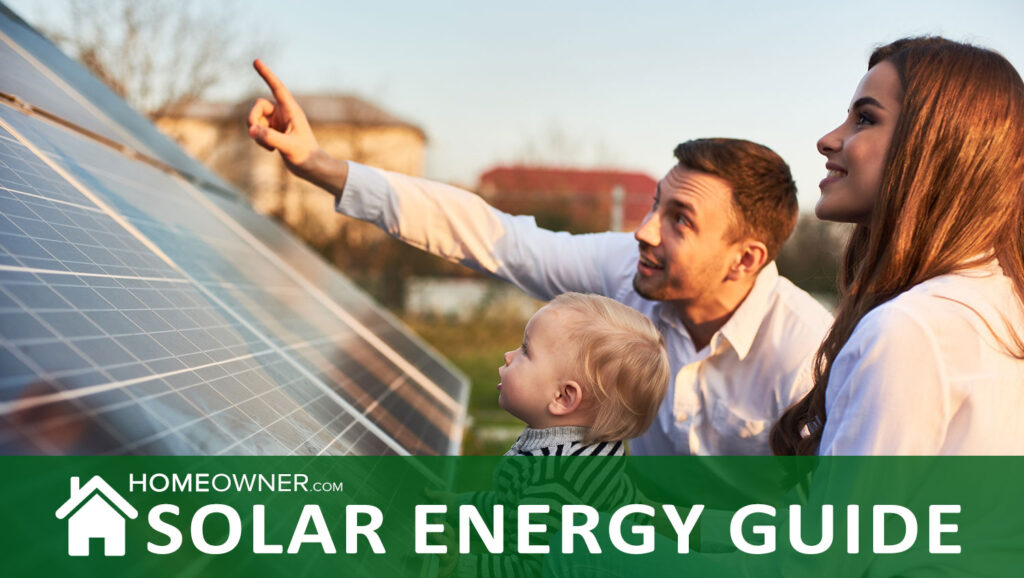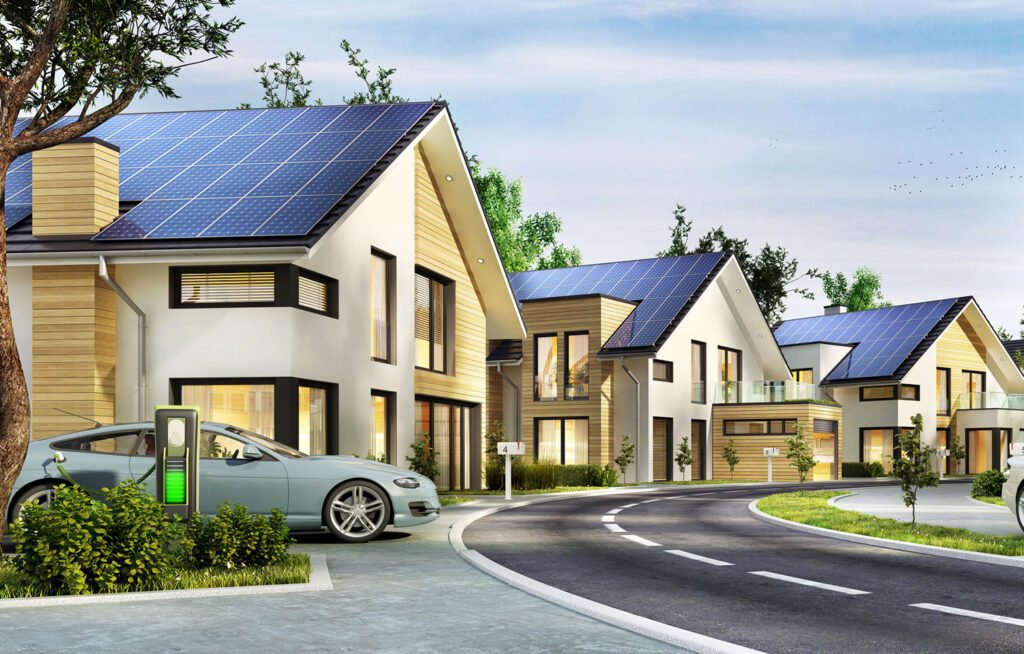The solar panel types available vary greatly. You can get them in different quality ranges, however, not every solar application requires the very best quality solar panels.
Most people just aim for somewhere in the middle of the quality scale when deciding on the types of PV panels they will use.
Get A FREE Home Solar Quote Now
If this decision is based on a good balance of price and power, then this is usually the best choice for solar energy.
What Types of Solar Panels Are Available?
There are three main solar panel types available for the purposes of residential and commercial solar energy systems.
Mono-crystalline Silicon Solar Panels
These kinds of solar panels which usually have a polka dot or checkered pattern are made of the smallest solar cells and therefore are the smallest, most efficient types of PV panels.
Mono crystalline solar panels are also the most expensive of all the main solar panel types. Since they provide more energy production per square foot of module, this makes them desirable for limited roof space solar applications.
If you don’t have a lot of roof space to work with, mono crystalline solar panels are the wisest choice of solar panel types regardless of the higher price.
Poly-crystalline Silicon Solar Panels
These kinds of solar panels (made of cells cut from multiple crystals) are the most popular choice worldwide. In fact, polycrystalline has now become the standard in Europe.
Although they are a little bigger, less efficient, and require more roof space than the mono-crystalline types of PV panels, they are also less expensive and provide an excellent balance of performance and price. Also, recent advances in poly-crystalline cell technology have made these solar panels almost as efficient and heat tolerant as mono-crystalline panels, which makes them even more appealing.
Amorphous (or thin film) Silicon Solar Panels
These kinds of solar panels are made with cells consisting of a micro-thin layer of silicon applied directly onto a sheet of glass or plastic. They are the types of PV panels that are the least efficient because they use the least amount of silicon in their solar cells and thus take up more roof space than the previous two solar panel types.
This is an important consideration if you don’t have a big area to work with or want to leave some space for future upgrades (adding more solar panels).
If you do, then you would probably be better off buying poly crystalline solar panels or if your available space is really tight, even mono crystalline solar panels.
Although these types of PV panels make less power per square foot of module, one advantage to amorphous solar panels is that they are more durable and versatile. They can be mounted on a larger variety of rooftops such as those of commercial factories as well as building-integrated applications involving roofing tiles or shingles. They are also the lowest priced of all the solar panel types.
Solar Roof Tiles
One more option to consider is solar roof tiles (also known as solar shingles). These are much smaller in size and fit onto your roof over or in place of your regular roof tiles.
Choose The Types of PV Panels Right For You
Though the types of solar panels available each have advantages and disadvantages, ultimately the choice is up to you.
If space isn’t a huge issue, we would personally recommend poly-crystalline panels (also known as multi-crystalline panels) as they will give you the most flexibility all-round, along with providing you will many competing brands to choose from.
Solar Energy System Types
Different types of solar power systems require different photovoltaic equipment along with varying orders of the PV components.
There are 4 different solar system types:
- Portable Solar System
- Grid-Intertied Solar System
- Grid-Intertied Solar System with Battery Backup
- Off-Grid Solar System
Each of these types of solar systems contains specific photovoltaic components that make up its structure.
To create any of the solar power systems listed below yourself, you must buy the necessary solar components and put them in the order specified. You must also keep your solar panels in good condition – here are some tips for solar panel maintenance.
Types of Solar Energy Systems
Portable Solar Systems
What are Portable Solar Energy Systems?
The simplest form of portable solar energy systems (also known as portable solar generators) can be built at home by connecting one or more homemade solar panels to an inverter you plug into for power. To be able to store energy, a charge controller and battery is used in between the panels and inverter.
Although we show you how to put together your own portable solar power system on this website, you are still going to want to explore the wonderful world of retail solar mobility and portable solar generators.
Retail Portable Solar Generators
There are all kinds of portable solar generators, products, and solutions for sale out there designed to make it easy for you to use solar power wherever you go to power laptops, cell phones, video cameras, small TVs & VCRs, work lights, for emergency power and for literally hundreds of other practical uses.
You can get Solar Power Packs (AC/DC) that look like little boom boxes and allow you to plug electronics directly into them.
A portable solar panel is used to charge the portable solar generator’s battery bank, so you can always make and store more power even away from home. With many models, you can also plug these things into the wall to recharge them.
Portable Solar Benefits
Portable solar energy systems can fill many important needs:
- Being portable, they can be conveniently taken with you and used practically anywhere.
- They are an easy way to start utilizing solar power without too many complicated parts and safety hazards.
- Portable solar energy systems usually come with plug and play cables and connections making it easy for the average person to use them almost instantly.
- Perfect as an emergency source of backup power, in blackouts or power shortages.
- Great for use in remote (off-grid) locations such as camping cabins.
The main advantage of these portable solar generator units is that they are really simple to use. Students can use them to research online while sitting in the park. Businesses can make presentations onsite. Teachers can use them in a variety of mobile educational applications.
There are no wires, so all you have to do is plug right into them which makes them perfect for even the most novice of users. In fact, with most of these systems, it only takes a beginner about 20 minutes to figure it out from start to finish and start benefiting soon after.
Convenient AC and DC Solar Power On The Go
Some of these backup solar power packs can even provide you with both the type of electricity available from your home’s power outlets (120 volts AC) and the type of power that is supplied by the battery of your car (12 volts DC).
This diversity means you’ll be able to power regular electronic devices (AC) and the kind used in RVs, campers, and trailers (DC).
Many of these mobile solar power systems also have built-in inverters which allow you to run appliances with a wattage draw of up to 300 continuous watts and more, with surge capability ratings of up to 500 watts.
Since you would normally use only one panel with a portable system, it obviously won’t power your entire house, but these types of solar systems will allow you to power individual appliances like TVs, laptops, refrigerators, and radios using the power of the sun. If you want to, you can add more panels to this system for more power.
Grid-Tied Solar Energy System
Grid-tied solar systems are used if you are still going to be getting some of your electricity from your power company. Of all the solar energy systems, this is one is the most economical.
In fact with these types of solar power systems, if you make more electricity than you use (and your house meter starts turning in reserve), you can get credited for the surplus power by your power company.
Consult your power company or the appropriate regulatory agency in your area for the details, rules, and regulations regarding connecting to your AC breaker panel and feeding power back into the grid.
To put this solar energy system together, you would have to build (or buy) solar panel(s), purchase the individual photovoltaic components needed, and hook everything up as shown below.
Grid-Tied Solar System + Battery Bank as Backup
The Grid Tied with Battery solar power system would be used if you wanted to be able to use solar power while relying on your power company for some of your electricity, however, you also wanted a battery bank as a backup so you can store power in it and thus buy as little electricity from the electric company as possible. Of all the solar system types, this is the most practical one.
These types of solar power systems are also ideal for emergency use, use during maintenance of your system, or on a day with little or no sunlight (or at night).
Consult with your power company or the appropriate regulatory agency in your area for the details, rules, and regulations regarding connecting to your AC breaker panel.
Off-Grid Solar Energy Systems
The off-grid solar power system would be used if you wanted to go completely off the utility grid. This means you would make all your own power and not rely on your local power company for any electricity at all. Of all the solar system types this one is the most independent.
These types of solar energy systems often use a generator to ensure that the battery bank can always be charged even when it’s not sunny.
To put this solar system together, you would have to build (or buy) solar panel(s), purchase the individual photovoltaic components needed, and hook everything up as shown below.
Pole Mounted Solar Panels
Learn about the various types of solar pole mounts and which ones are right for your PV system.
What Are Pole Mounted Solar Panels?
Pole-mounted solar panels use a pole (instead of a rooftop) to elevate and support them to the desired height. Pole mount solar power is commonly used in backyard applications to keep the panels off the ground and out of harm’s way but yet still easy enough to adjust and to reach for snow removal.
Types of Solar Pole Mounts
Solar pole mounts available for pole-mounted solar panels are divided into 3 categories: Top of pole mounts, side of pole mounts, and poll tracking mounts. Their names reflect the position the panels get mounted in on the pole and to some extent their functionality.
Top of Pole Mounts
The top of pole solar pole mount is typically used for larger solar panels. With top of pole mounts, the solar panel is bolted to a rack that sits on top of the pole. A 3-8 inch wide pole made for top of pole PV applications is required as well as a secure concrete base.
If they are very big and heavy, top of pole mounts can be more difficult to install – especially in windy conditions. It’s common for large pole mount installations to require the help of a crane and many workers to be performed safely.
There are top of pole mounts that hold single solar panels and ones that hold several panels. Some people buy these units with extra space available so they can add more pole-mounted solar panels in the future.
Side of Pole Mounts
Side of pole solar pole mounts are typically used for smaller pole-mounted solar panels but some can hold up to four of them. With side of pole mounts, the PV panel is bolted to a rack that’s attached to the side of a pole.
Often, existing utility and telephone poles are used which eliminates the need to erect your own pole.
This type of pole mount solar application can save you considerable time, work and money, however, make sure you consult with your local utility or telephone company for confirmation that it’s okay.
Side of pole mounts are only recommended for small solar panels, for larger panels, you should use a top of pole mount.
Tracking Pole Mounts
Tracking pole mounts are just like top of pole mounts. They look similar, they both hold pole-mounted solar panels, except tracking solar pole mounts have one additional function:
They track the movement of the sun throughout the day and follow it.
By automatically adjusting to the best possible angle, this solar pole mount improves the panel’s efficiency, and solar power production increases.
Tracking pole mounts are generally more expensive than the other two pole mount systems, however, because they increase the efficiency of your pole mounted solar panels, they can save you more money over a longer period of time.
Regardless of which one of the solar energy systems you choose to implement, you’re going to need to set it up and make sure it’s all working correctly.
Testing Your Solar Panels
How to test solar panels to make sure they’re working properly.
Procedure For Testing Solar Panels
Properly testing your solar panels is a very important but often overlooked procedure. You wouldn’t believe how many people completely skip testing solar panels and forget to confirm their solar power output before installing them.
By learning how to test solar panels you can ensure that you don’t waste your time installing panels that you’ll have to take down and fix.
How To Test Solar Panel Output
Testing solar panels is easy. You can test your completed 63 watt solar panel, by using your multimeter (like you did before with your solar cells and your stringers).
Testing Solar Panels For Volts
To test solar panel voltage output, put your solar panel in direct sunlight, set your multimeter to the “volts” setting.
The next step:
- Touch the multimeters (red) positive lead to your solar panel’s positive wire.
- Then touch the multimeters (black) negative lead to your solar panel’s negative wire.
The volt reading on your multimeter should be close to (or just under) 60 volts. If it’s not, there is a problem with your solar panel output. Go back and check all the connections of your solar cells and all your stringers or check for cracks in the solar cells themselves.
Solar Panel Testing For Amps
To test solar panel amperage output, put your solar panel in direct sunlight, set your multimeter to the “amps” setting.
The next step:
- Touch the multimeters (red) positive lead to your solar panel’s positive wire.
- Then touch the multimeter’s (black) negative lead to your solar panel’s negative wire. The amp reading on your multimeter should be close to (or just under) 3.5 amps.
- 3 amps rating is about normal since your panel may not be currently getting maximum sunlight. If the amps are much lower there is a problem with your solar panel output. Go back and check all the connections of your solar cells and all your stringers or check for cracks in the solar cells themselves.
After doing your solar panel testing, you should find that the solar panel output is about 18 volts and 3.5 amps.
Whenever you have these two values you can figure out the wattage by multiplying them together.
Volts x Amps = Watts
18 Volts x 3.5 Amps = 63 Watts
Look For More Functionality In The Future
With the advancement of the latest solar power technology, solar systems and devices are sure to become more sophisticated and practical in the future. Soon solar power will likely be commonplace in society with dads warming up their kids’ lunches with solar power at a picnic and moms using the same solar power to attend a virtual business meeting online while in the wilderness.
Keep an eye out for new portable solar generators and other solar applications as you may be surprised how much convenience can be crammed into a small-sized solar energy system in days to come.
The sooner you can grasp (and get used to using) this free form of renewable energy, the sooner you will begin to realize the benefits of real energy independence.





